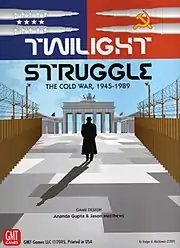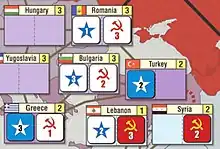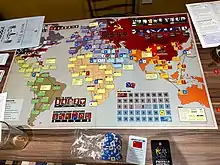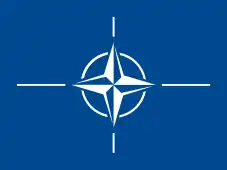| The Cold War, 1945–1989 | |
|---|---|
 First edition box art | |
| Designers | Ananda Gupta Jason Matthews |
| Illustrators | Viktor Csete Rodger B. MacGowan Guillaume Ries Mark Simonitch |
| Publishers | GMT Games |
| Publication | 2005 |
| Genres | Wargame |
| Players | 2 |
| Setup time | 5–15 minutes |
| Playing time | 3 hours |
| Chance | Medium (dice, cards) |
| Skills | Strategy Card management |
Twilight Struggle: The Cold War, 1945–1989 is a board game for two players, published by GMT Games in 2005. Players are the United States and Soviet Union contesting each other's influence on the world map by using cards that correspond to historical events. The first game designed by Ananda Gupta and Jason Matthews, they intended it to be a quick-playing alternative to more complex card-driven wargames.
It achieved critical acclaim for its well-integrated theme, accessibility and introduction of Eurogame elements. After being voted the number one game on BoardGameGeek from December 2010 to January 2016 (eventually dethroned by Pandemic Legacy), it has been called "the best board game on the planet".[1] Twilight Struggle is played competitively and was unofficially adapted for play-by-email and live online play. GMT released a Deluxe Edition in 2009, as well as a Collector's Edition as part of the crowdfunding campaign for the game's official adaptation into a video game; this Digital Edition was released in 2016. With over 100,000 copies sold, the game is GMT's all-time best-seller.[2]
Gameplay overview

According to its designers, "Twilight Struggle basically accepts all of the internal logic of the Cold War as true—even those parts of it that are demonstrably false."[3] The game board thus presents a map of a bipolar world according to domino theory, where the US and USSR spread influence to all other countries (except China, which is shown as a powerful card, which must be handed to the other player if used, representing China tilting from one bloc to the other), and attempt to establish control depending on the stability of a country. One scholarly analysis proposed that "[w]hile Twilight Struggle is at its core an area control game, what set its apart from being marked as a Risk clone is the combined effect of material aesthetics and design mechanics meant to embrace a particular point of view tied to the Cold War zeitgeist."[4]
Gameplay is divided into ten turns. Each turn players randomly draw a hand of event cards from a single deck. The starting deck contains only early war cards, with historically appropriate mid war and late war events shuffled in on turns 4 and 8 (for a total of 103 cards in the first edition). Players both use a card in the turn's headline phase (in which each player must play a card for its event) and six to eight action rounds.

Operations and events
Cards have operations point values that let a player take one of three actions on the board: to place influence markers in or adjacent to countries where he already has influence; to attempt realignment to remove enemy influence, with bonuses depending on existing influence; or to attempt a coup that can reduce an opponent's influence and increase his own influence in a single country. Realignment and coup attempts partially rely on dice rolls to succeed.
If a card's event is associated with that player, or neutral, the player must choose either to conduct operations or get the beneficial effect of the event. However, if a player conducts operations using a card with an opponent's event, the event occurs as well. For example, the US player can use two operations points from playing the Soviet event "Fidel", at the expense of its effect: "Remove all US Influence in Cuba. USSR gains sufficient Influence in Cuba for Control." A further option, allowed once per turn, is to expend a card attempting to advance in the Space Race, avoiding triggering that card's event. Strategy requires players to anticipate reactions to what their opponent might play.[4]
Scoring and victory
Regional scoring cards award victory points to both players based on their respective level of influence—presence, domination or control—in that region when the card is played. The regions have unequal values: domination of Central America is worth three VP but domination of Asia is worth seven. Normally players will hold one card per turn into the next, but scoring cards may not be held.
Player actions are constrained by the DEFCON and required military operations tracks. A coup attempt on one of the battleground countries reduces DEFCON by one each time, restricting the regions where coups and realignments may be attempted. If DEFCON 1 is reached during a player's action round, that player is deemed to have caused a nuclear war and loses immediately. Each turn, however, players will also lose victory points if they do not conduct military operations (coup attempts or playing war events) at least equal to the DEFCON level.
Victory points are gained or lost on a shared one-dimensional track, and a player who reaches 20 VP in his or her favor wins immediately. Control of Europe when its scoring card is played also awards an early victory. If neither player has won by the end of turn 10, a final scoring occurs in which each region is scored once.
According to an analysis of the game's design, "In some respects, Twilight Struggle resembles a modern-style Eurogame more than a wargame", in that the game offers multiple paths to score and win. It summarized the game play thus: "Rules and limited strategic choices governing Event triggers combine to ensure a roughly-accurate historical experience; within this framework of bad and suboptimal choices, one player will eventually squeak out a victory."[5]
Theme
Although Twilight Struggle was designed to be simple and playable, it has strongly thematic gameplay – that is, the rules reflect the logic of the Cold War, and the cards refer to actual historical people and events, generally being illustrated with historical photographs. For example, the rule that a player may only add influence to a country where they already have influence or to an adjacent country means that players’ influence moves across borders in a predictable way, simulating domino theory.[3] Meanwhile, the Space Race track includes steps named "Man in Space", a reference to Yuri Gagarin, and "Space Shuttle".
Meanwhile, individual cards reference not only major historical happenings, such "Marshall Plan", "Destalinisation", and "Captured Nazi Scientists", which invokes Operation Paperclip, but small-scale ones, such as "Yuri and Samantha", based on schoolgirl Samantha Smith's visit to the Soviet Union. Other events reflect the culture of the Cold War, such as "Voice of America" and "Olympic Games", which allows one player to boycott the Games. A few are metatextual, such as "How I Learned To Stop Worrying" and "Wargames", both referring to films about the Cold War and even wargames themselves.[6]
Development


Wargaming hobbyists Jason Matthews and Ananda Gupta met in 1998 at a board gaming club at George Washington University.[7] They hoped to take advantage of a resurgence in wargaming led by card-driven games, but wanted a quick-playing game to fit their own schedule—more in the vein of We the People and Hannibal: Rome vs. Carthage than the likes of Paths of Glory. They rejected a Spanish Civil War theme after realizing they did not know enough about the period. Gupta suggested the Cold War theme, which fit well for Matthews, who had studied it extensively when majoring in international relations in the 1980s.[3] According to Matthews, the Cold War had not been depicted in a two-player board game before.[8]
Design drew on many other games. The influence-based scoring system derived from History of the World, and scoring cards from the work of Alan Moon. Using game mechanics to incentivize historical behavior came from experience with For the People. The futility of nuclear war, and its relation to conventional military operations, came from the video game Balance of Power as well as Supremacy.[5] Twilight Struggle takes its title from John F. Kennedy's inaugural address.[9] Early versions were more complex and simulation-like, but through playtesting eventually almost every mechanic was abstracted and the event deck made much smaller: "Many clever and interesting ideas were discarded as being contrary to the fundamental guiding principles of the game – fast play, simple rules, and getting a lot of gameplay value out of the cards."[10]
By the summer of 2000, Matthews and Gupta were promoting a prototype at the World Boardgaming Championships. Their first choice of publisher was GMT Games, where Gupta had had a playtesting job. GMT founder Gene Billingsley immediately felt drawn to the theme but had doubts about the game's marketability, and placed it on the company's Project 500 list—it would be published if it achieved 500 preorders. The game ultimately shipped in December 2005 with a retail price of $57.[11][7]
Later editions
Matthews subsequently wrote a set of optional rules to simulate the Chinese Civil War,[12] and Volko Ruhnke developed a scenario starting in the late war era.[13] Both were included with the Deluxe Edition in 2009, in addition to new map art, event text revisions and a set of optional cards.[14]
In addition to a Collector's Edition made with luxury materials, potential bonuses with Digital Edition preorders were a set of new cards and the Turn Zero mini-expansion, which adds an earlier starting point and the possibility that historical events such as the 1945 United Kingdom general election, the Battle of Berlin, or the Chinese Civil War happened differently.[15] GMT made a reprint of the new cards and expansion available for general purchase.[16]
In 2022, GMT released Jason Matthews's game Twilight Struggle: Red Sea.[17] Based on the Horn of Africa in the 1970s, especially the deposition of Haile Selassie,[18] it is designed to play similarly to the original game but only take 35 minutes to play. In addition, cards from Twilight Struggle and Red Sea may be used in either game.[19]
Reception
Initial reviews were positive but sales were not as successful. However, when Alan Moon, an influential designer of Eurogames, endorsed the game the first printing sold out quickly.[7] According to one account, "Twilight Struggle came out the same weekend as the Boardgame Players Association's Winter Activation Meeting ... Though it was not an event on the schedule, Twilight Struggle was the talk of the show ... At PrezCon a month later, the dealer sold out in the first few minutes he was open."[20]
Jon Waddington for Gamers Alliance Report was positive but noted problems with unclear card and rule book texts (in the first edition). "I cannot quite give Twilight Struggle an unqualified recommendation, and yet I consider it one of the best games I've played in the last few years."[21] Rating the game 93%, Armchair General reviewer Kaarin Engelmann pointed out that "One of its strengths is that few other games deal with the subject, yet it is not important to remember pre-Glasnost years to enjoy the game."[20] Game designer Zev Shlasinger commented: "Twilight Struggle gives you a compact history lesson about the Cold War ... Coupled with that is the game's accessibility and the design's cleverness, all of which make Twilight Struggle stand out among the crowd of recent political wargame releases."[22]
Users voted Twilight Struggle the highest-ranked game on BoardGameGeek from December 2010 until it was unseated by Pandemic Legacy in January 2016.[23] This led later commentators like FiveThirtyEight's Oliver Roeder to call it "the best board game on the planet";[1] Vice Motherboard's Michael Gaynor called it "the best board game ever created".[24] It became GMT Games' all-time best-seller, with lifetime sales of approximately 100,000 copies as of July 2016.[2]
Awards
- 2005 – Charles S. Roberts Award for Best Modern Era Boardgame and James F. Dunnigan Award (to Gupta and Matthews)[25]
- 2005 – Nominated for Origins Award for Historical Boardgame of the Year[26]
- 2006 – International Gamers Award for Best 2-Player Strategy Game and Best Historical Simulation Game, the first game to win two IGAs.[27]
- 2006 – BoardGameGeek Golden Geek Award for Best Wargame and Best 2-Player Board Game[28]
- 2006 – Nominated for the Diana Jones Award for Excellence in Gaming[29]
- 2007 – Nominated by Games magazine for Best Historical Simulation[30]
- 2011 – Lucca Comics & Games Best of Show in Boardgame for Experts (for Italian edition by Asterion Press)[31]
- 2012 – Ludoteca Ideale winner (Italian edition)[32]
- 2012 – Gra Roku nominee (for Polish edition by Bard Centrum Gier)[33]
Influence
Jason Matthews reused mechanics of Twilight Struggle in several games. For example, in 1960: The Making of the President, the countries are replaced by states, and victory points are replaced by electoral votes deciding the 1960 United States presidential election. Similar adaptations are Campaign Manager 2008, 1989: Dawn of Freedom and Founding Fathers.[5] Volko Ruhnke used it as the "starting point" for the mechanics of Labyrinth: "What would Twilight Struggle look like if it were covering 2004 to 2009?"[34]
Matthews and Gupta next collaborated on Imperial Struggle: The Global Rivalry Between Britain and France, 1697–1789. Gupta characterized Twilight Struggle as an "older cousin" to Imperial Struggle.[35]
Online play
Following a crowdfunding campaign on Kickstarter, Twilight Struggle Digital Edition was released in 2016. Developed by Playdek and published by Asmodee Digital, this paid version allows play against a computer in addition to another player. It was released for Windows, macOS, iOS and Android;[24][36] the campaign had also promised a Linux edition.[37]
Before 2016, it was available in Wargamesroom[38] for PC.
Other alternatives, allowed by GMT games only if at least one player owns the board game are:
Competitions
Twilight Struggle has been played in different online and live tournaments since 2005. Currently, among the most relevant active tournaments, the following stand out:
- International league (hybrid: online and face-to-face): ITSL
- International online leagues: OTSL and RTSL
- Asynchronous international leagues: RATS and BPA Tournament
- National leagues: KTSL, LFTS, French League, UK League, Greek League, LPTS, Nordic League and various regional American leagues.
- On-site championships: TS Convention, WBC Tournament[44]
- 2-Day Online Tournaments: Online World Cup, Mind Sports Olympiad, Grand Slams
- Team Tournaments: Nations Cup and US Cup
Most of these championships count their results within a unified rating (ITS Rating[45]), allowing to know in advance the level of each player and thus being able to balance the schedules in an optimal way. Some of the competitions are broadcast live with commentators in specialized channels like ActionRoundZero[46] or Caecius.[47]
The original rule book included the tournament rule of revealing held cards at the end of a turn, to prevent cheating by holding a scoring card. In more modern competitions this was replaced by showing the bottom of the card, demonstrating that it is not a scoring card.
The Deluxe Edition rule book includes an annotated "Extended Example of Play" taken from a Boardgame Players Association play-by-email tournament. The Collector's Edition rule book provides for tournament players to bid starting influence on their preferred side. In most of the current competitions, +2 influence points for USA and option cards are used as standard, obtaining a balance very close to 50% between both sides.
The original rules allow for a tie, although in the Playdek application in case of a tie in Final Scoring the victory is given to the American player and in case of a tie through Wargames the victory is given to the player who did not event the card. Most of today's competitions follow the original rules and therefore allow for ties.
ITSL
ITSL (International Twilight Struggle League) is the oldest active tournament in Twilight Struggle, since 2006, including most important Twilight Struggle players. Jason Matthews himself played in the first edition.
| Edition | Number of players | Number of games | Winner | Runner-up |
|---|---|---|---|---|
| 2006 | 20 | 138 | ||
| 2007 | 48 | 299 | ||
| 2008 | 49 | 282 | ||
| 2010 | 50 | 290 | ||
| 2012 | 44 | 276 | ||
| 2013 | 53 | 340 | ||
| 2014 | 63 | 345 | ||
| 2015 | 60 | 359 | ||
| 2020 | 107 | 1083 | ||
| 2021 | 207 | 2155 | ||
| 2022 | 240 | 2306 | ||
| 2023 | 240 | 2058 |
Nations Cup
The Nations Cup is played by national teams who take decisions by consensus. The competition starts with a Qualifying Stage, after which the strongest teams play in the Final Stage.
| Edition | Number of nations | Winner | Runner-up | Third place |
|---|---|---|---|---|
| 2021 | 18 | |||
| 2022 | 26 | |||
| 2023 | 21 | TBD | TBD | TBD |
See also
References
- 1 2 Roeder, Oliver (December 31, 2014). "Designing The Best Board Game On The Planet". FiveThirtyEight. Retrieved July 7, 2019. With prototype map.
- 1 2 Billingsley, Gene (July 20, 2016). "GMT Games: State of the Union (Summer 2016)". Inside GMT.
- 1 2 3 Matthews, Jason; Gupta, Gupta (2009). "Designer's Notes". Twilight Struggle: The Cold War, 1945–1989, Deluxe Edition Rule Book (PDF). Hanford, California: GMT Games. p. 31.
- 1 2 Antley, Jeremy (2016). "Struggling with Deep Play: Utilizing Twilight Struggle for Historical Inquiry". In Harrigan, Pat; Kirschenbaum, Matthew G. (eds.). Zones of Control: Perspectives on Wargaming. pp. 463–470. ISBN 9780262033992.
- 1 2 3 Harrigan, Pat; Wardrip-Fruin, Noah (2011). "Twilight Struggle and Card-Driven Historicity". In Costikyan, Greg; Davidson, Drew (eds.). Tabletop: Analog Game Design. n.p.: ETC Press. pp. 158–166. doi:10.1184/R1/6686933.
- ↑ Matthews, Gupta, Jason, Ananda (September 2016). Twilight Struggle: The Cold War, 1945-89, Deluxe Edition Rule Book. Hanford, California: GMT Games. pp. 20–30.
{{cite book}}: CS1 maint: multiple names: authors list (link) - 1 2 3 Gaynor, Michael J. (July 17, 2018). "They created maybe the best board game ever. Now, Putin is making it relevant again". The Washington Post Magazine. Retrieved July 7, 2019.
- ↑ Ligabue, Andrea (June 13, 2016). "The Art of Design: Interviews to Game Designers #26 – Jason Matthews". Opinionated Gamers. Retrieved September 2, 2019.
- ↑ "Now the trumpet summons us again—not as a call to bear arms, though arms we need; not as a call to battle, though embattled we are—but a call to bear the burden of a long twilight struggle, year in and year out, 'rejoicing in hope, patient in tribulation'—a struggle against the common enemies of man: tyranny, poverty, disease, and war itself." "Inaugural Address of John F. Kennedy". Avalon Project. January 20, 1961. Retrieved July 7, 2019.
- ↑ Gupta, Ananda (2006). "Twilight At Last: Inside the Design of Twilight Struggle". C3i Magazine. No. 18.
- ↑ "Twilight Struggle" (PDF). Inside GMT. Winter 2005. p. 3. Archived from the original (PDF) on December 24, 2005.
- ↑ Matthews, Jason (2008). "Let a Thousand Variants Bloom: The Evolution of the Chinese Civil War and the Long, Twilight Struggle". C3i Magazine. No. 21.
- ↑ Volko, Ruhnke (2007). "A Short Scenario for Twilight Struggle". C3i Magazine. No. 19.
- ↑ Wray, Chris (April 26, 2017). "Twilight Struggle Collector's Edition (Photos and Game History by Chris Wray)". Opinionated Gamers. Retrieved July 7, 2019.
- ↑ "Twilight Struggle: Turn Zero". boardgamegeek.com. Retrieved 4 November 2021.
- ↑ "Twilight Struggle Turn Zero and Promo Packs, 2nd Printing". GMT Games. Retrieved July 7, 2019.
- ↑ "Twilight Struggle: Red Sea - Conflict in the Horn of Africa". GMT Games. Retrieved 25 January 2023.
- ↑ Matthews, Jason. "Inside the History of Twilight Struggle: Red Sea (Part One)". insidegmt.com. Retrieved 4 November 2021.
- ↑ "Twilight Struggle: Red Sea Rule Book" (PDF). Retrieved 25 January 2023.
- 1 2 Engelmann, Kaarin (March 14, 2006). "Twilight Struggle – Boardgame Review". Armchair General. Retrieved July 7, 2019.
- ↑ Waddington, Jon (Spring 2006). "Twilight Struggle". Gamers Alliance Report. Retrieved July 7, 2019.
- ↑ Shlasinger, Zev (2007). "Twilight Struggle". In Lowder, James (ed.). Hobby Games: The 100 Best. Green Ronin Publishing. pp. 335–337. ISBN 978-1-932442-96-0.
- ↑ Wray, Chris (January 1, 2016). "Congratulations to Pandemic Legacy, BGG's new #1 game…". Opinionated Gamers. Retrieved July 7, 2019.
- 1 2 Gaynor, Michael. "The Best Board Game Ever Created Is Finally Available on Steam". Motherboard. Retrieved July 7, 2019.
- ↑ "Charles S. Roberts Award Winners (2005)". CSR Awards. Archived from the original on January 17, 2010.
- ↑ "Historical Board Game of the Year". Origins International Game Expo 2006. Game Manufacturers Association. Archived from the original on June 17, 2006.
- ↑ Arneson, Erik. "Best Boardgames of 2006". About. Archived from the original on January 25, 2007. Retrieved July 17, 2007.
- ↑ "2006 Golden Geek Awards". BoardGameGeek. Retrieved July 8, 2019.
- ↑ "The Diana Jones Award 2006". Diana Jones Award. Retrieved July 8, 2019.
- ↑ O'Hara, Walt (December 2006). McCallion, John J. (ed.). "2007 Buyer's Guide to Games – The Traditional Games 100: Historical Simulation – Twilight Struggle". Games Magazine. p. 48.
- ↑ "Best of Show: i vincitori". Lucca Comics & Games 2011 (in Italian). Retrieved August 26, 2019.
- ↑ "2012". Ludoteca Ideale (in Italian). Archived from the original on August 19, 2014.
- ↑ "Edycja 2012". Konkursu Planszowa Gra Roku (in Polish). Retrieved August 26, 2019.
- ↑ Owen, Duffy (August 3, 2017). "An Interview with Volko Ruhnke on Labyrinth". BoardGameGeek. Retrieved August 26, 2019.
- ↑ Gupta, Ananda (January 5, 2018). "A Struggle Anew: Imperial Struggle and Its Older Cousin". Inside GMT. Retrieved July 7, 2019.
- ↑ Hall, Charlie (April 14, 2014). "One of the best board games ever made is now live on Steam". Polygon. Retrieved July 7, 2019.
- ↑ GMT Games. "Twilight Struggle Digital Edition". Kickstarter. Retrieved July 7, 2019.
- ↑ Wigdor, Bruce. "Wargameroom Downloads". Wargameroom. Retrieved July 8, 2019.
- ↑ "Saito Arcade". saito.io. Retrieved 2021-08-17.
- ↑ "Twilight Struggle". Automated Card Tracking System. Warhorse Simulations. Retrieved July 8, 2019.
- ↑ "GMT Cyberboard Gameboxes". GMT Games. Retrieved July 8, 2019.
- ↑ "GMT VASSAL Modules". GMT Games. Retrieved July 8, 2019.
- ↑ Trill, Jason. "Virtual Twilight Struggle board". TwiStrug. Retrieved July 8, 2019.
- ↑ "Twilight Struggle (TWS) Event History & Laurels". Boardgame Players Association. October 20, 2018. Retrieved July 8, 2019.
- ↑ "Twilight Struggle Rating". Twilight Struggle. Retrieved 2023-08-30.
- ↑ "Twitch". Twitch. Retrieved 2021-08-17.
- ↑ "Twitch". Twitch. Retrieved 2021-08-17.